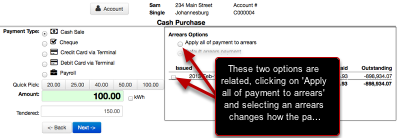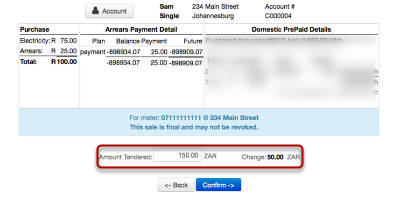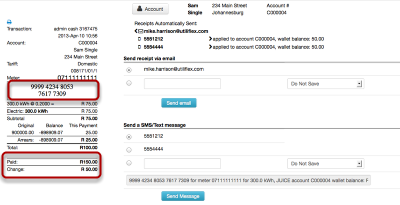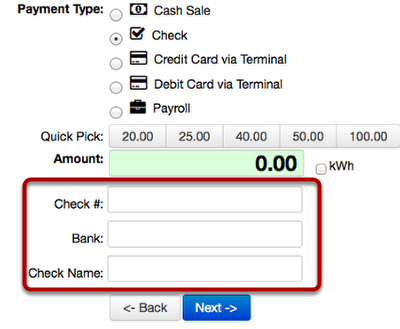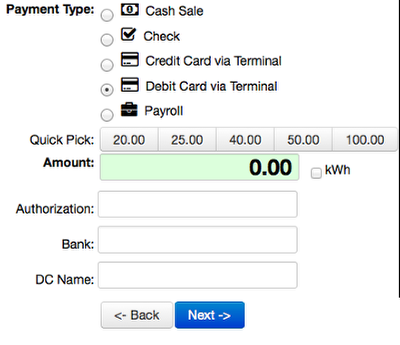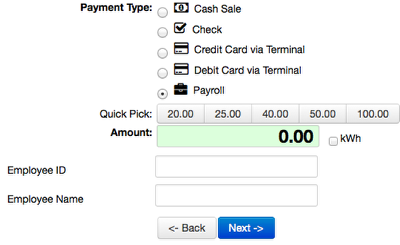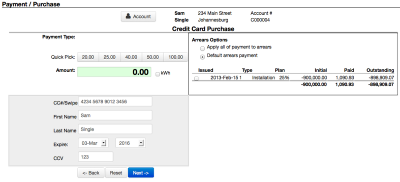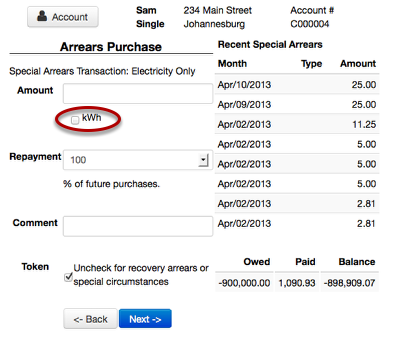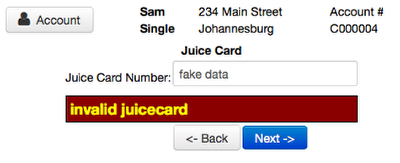Other Vending Methods
Quick Pay is a term used in Juice for buying power. It's normally used for cash transactions but other payment methods are also available.
Quick Pay Overview
Except for a Write Off, with the corresponding permissions, you can vend electricity to customers using these methods.
Quick Pay: Cash
This is the same interface that the shopping cart uses, only access from the customer account by clicking the blue Cash button. Once the amount of the purchase is entered and the arrears option (if applicable) is selected, click Next.
Quick Pay: Cash Confirmation
The confirmation page is also the same, notice in this example an amount greater than the amount of the purchase was entered and Juice returns a change amount. Once you have reviewed the transaction, click Confirm.
Quick Pay: Cash Receipt
The receipt page has the sms and email options, and displays the default receipt layout. Notice the STS token, amount paid, and change is all on the receipt. This layout can change per deployment especially if printed receipts are not used (some deployments default to SMS receipts only).
Quick Pay: Cash Payment Types
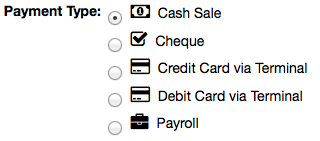
While the Cash button defaults to a cash sale, it does have options for Check, Credit/Debit Card via Terminal, or Payroll payments. These are system defaults that can be customized per installation and differ from the other quick pay buttons.
Quick Pay: Cash (Check Payment)
Check payments have the same logic for application and receipt as cash sales. You'll notice there are new fields for relevant check information. These are not required but will make your boss happy and auditing customer accounts more accurate for everyone. Please double check information entered here for accuracy.
Quick Pay: Cash (Credit/Debit via Terminal)
This option is used when a cashier has a credit card or debit card terminal used for payments. Similar to the Check Payment this is useful for record keeping purposes.
- Authorization - The authorization number given for a successful credit card transaction from the terminal.
- Bank - Name of the company that issued or backs the debit/credit card.
- DC Name / CC Name - Name of the card holder.
Please follow company policy to avoid credit card fraud.
Quick Pay: Cash (Payroll)
This option shows an option where payroll deductions can be used to pay for power in Juice. This is a good example of a unique payment method that may not be included in every installation but showcases different ways that Juice can incorporate company policy into the system.
Quick Pay: Credit Card
This is different from the Cash (Credit/Debit via Terminal) options. Juice can be set-up to run credit cards securely without a separate credit card terminal. For the transaction to be successful all available fields will need to be filled out.
Please follow company policy to avoid credit card fraud.
Quick Pay: Arrears Vend
Arrears vending allows users (commercial managers or supervisors) to have the ability to grant an “emergency credit” on an arrears basis to provide a consumer power during extenuating circumstances. The utility will define the maximum amount of credit which may be provided (recommended to be no more than 7 days of typical consumption).
This capability is not generally provided to cashiers and 3rd party merchants. This functionality is optional and can be disabled.
Mechanically it works like a purchase, only the customer will pay the amount purchased in the future. Notice the kWh option, since the idea is to allow the customer to use power for X number of day vending by kWh instead of currency may be more meaningful to the customer.
For example with normal usage of 20 kWh per day and a rate of 0.25/kWh; 100 kWh will cost 25.50 local currency and last a little under a week.
Quick Pay: Juice Card
Juice frequently is deployed with prepaid scratch cards called Juice cards. They are managed by Juice and due to the policies in place for card management, they are useless if stolen and once redeemed are unique to a specific meter. This is done to make them a low risk item to the utility and customers. Once they are redeemed they cannot be reused or shared. Because of this all sales are final.
Quick Pay: Wallet Vend
In Juice, the Wallet is a useful concept that both customers and the utility can use to manage the customer's money. It works like a mobile wallet making it easy for customers to understand. Funds can be applied from the Wallet to purchase power using the Wallet button on the customer account screen. The amount paid from the Wallet must be less than or equal to the amount in the wallet.
